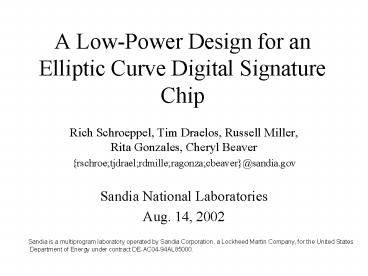A LowPower Design for an Elliptic Curve Digital Signature Chip - PowerPoint PPT Presentation
1 / 20
Title:
A LowPower Design for an Elliptic Curve Digital Signature Chip
Description:
Public key authentication in resource constrained environments ... Bump-in-the-wire option. Application Concept. Nuclear Material Monitoring & Inventory Application ... – PowerPoint PPT presentation
Number of Views:36
Avg rating:3.0/5.0
Title: A LowPower Design for an Elliptic Curve Digital Signature Chip
1
A Low-Power Design for an Elliptic Curve Digital
Signature Chip
- Rich Schroeppel, Tim Draelos, Russell Miller,
Rita Gonzales, Cheryl Beaver - rschroetjdraelrdmilleragonzacbeaver_at_sandia.g
ov - Sandia National Laboratories
- Aug. 14, 2002
Sandia is a multiprogram laboratory operated by
Sandia Corporation, a Lockheed Martin Company,
for the United States Department of Energy under
contract DE-AC04-94AL85000.
2
Motivation
- Public key authentication in resource constrained
environments - E.g. Battery operated, unattended sensor-based
monitoring - Low power for signature generation
- Design choices balance between power, size, and
speed - Short signatures (356 bits)
- Low Bandwidth
- Standalone chip, or piece of larger chip
- Bump-in-the-wire option
3
Application Concept
- Nuclear Material Monitoring Inventory
Application - Fiber Optic Tamper Indication
- Motion, Temperature sensors
- Two-way wireless communication
- Message authentication/encryption
- Battery life in excess of 5 years
- Reduced size (1.5x 4.1x 4.6)
- Low cost module (550 estimate)
4
Design Choices
- Elliptic Curve Optimal El Gamal Signatures
- No modular reciprocals
- Elliptic Curve (EC) uses characteristic 2 field,
GF(2178) - VHDL for portability
- Designed-in power management
5
Algorithm Components
- Elliptic Curve operations for signature
- Point multiplication
- HalveAdd Method
- Signed Sliding Window multiplication
- Pre-compute 3P,5P,7P
- Finite Field Operations
- Elliptic curve operations are built up from
finite field primitives such as multiplication,
reciprocal, and solving a quadratic equation
6
Algorithm Optimizations
- EC Point halving
- Point-slope form
- Field Towers
- Almost Inverse Algorithm
- Fast degree comparison, fast shift, fast fix-up
- Quadratic Solve circuit design
- Field multiplication radix 16
- Trinomial field basis
7
The Signature Scheme
- Parameters
- Public Elliptic Curve E, Point G(xG,yG)
- of order r, Field GF(2n), Public Key W sG
- Private long term private key s, 0 lt s lt r
- Signature On message, M
- fHash(M).
- Choose per message random, v.
- Compute V vG (xV,yV).
- c xV (mod r)
- d cfsv (mod r)
- Signature is (c,d)
- Verification On received input (M,c,d)
- If c lt0 or cgtr-1, output reject and stop
- f Hash(M)
- h cf (mod r)
- P dG - hW (xP,yP)
- c xP mod r
- If c c then output accept else reject
8
Point Halving
- 3 times faster than doubling
- No reciprocals
- E y2 xy x3 ax2 b
- Use point in (x,r) format (r y/x) (point-slope)
- Input P (xP,rP) Output Q (xQ , rQ) where
2QP - Mh Qsolve(xPa)
- T xP(rPMh)
- If parity(tmT)0 then
- Mh Mh 1 T T xP
- tm is a trace mask depending on the field
- xQ rQ Mh xQ 1
9
Field Towers
10
Field Towers
- Arithmetic based in GF(289),
- e.g.
- E y2 xy x3 ax2 b
- Fixed a (1,0) for simplicity
- b variable
- Main optimizations done over GF(289)
- Order of G 177 bits is equivalent to 1500 bit
RSA - Not subject to known field tower attacks
11
Quadratic Solution
- Qsolve(a) z where z2 z a
- Qsolve for GF(289)
- Input a (a00,a01,,a88), output z (z00,,z88)
- Compute odd z01z19 directly
- Solve equations for other zn
12
Gate-Depth Tradeoff
- Developed special circuit with relatively small
number of XOR gates (387) and depth (35) - Faster with more gates, but traded speed for size
13
Hardware Architecture Design
- Full VHDL implementation that can be targeted to
FPGA or ASIC - Bottom up approach
- I/O Interface intended to be used as a
memory-mapped device - Hang off of microprocessor bus
- 16-bit address bus
- 8-bit data bus
- Control Signals
- Interrupt signals used to indicate signature
status, error or signature completion
14
Hardware Architecture Design
- Functionality
- Signature, SHA-1 Hash Algorithm, Pseudo-random
number generation - Flexibility
- Input message or hash of message
- Input random per-message nonce, or seed for a
pseudo-random nonce - Parameters private key, generating point (Curve
equation) - Output signature, message hash, public key
15
Secure Signature Chip Design
16
Gate counts
- Chip 191,000
- Control 27,000
- SHA-1 13,000
- Remainder 6,700
- Signature Algorithm 143,000
- Control 15,000
- Multiply 6,200
- Remainder 6,800
- Point Multiplication 112,000
- Register Control 30,000
- Point Addition 52,000
- Point Halving 29,000
17
Power control in hardware design
- Clock gating
- Inactive portion of chip turned off
- Point halver
- Point adder
- Remainder
- Multiplier
- Finer granularity possible
18
Other Hardware Optimizations
- SHA-1 shift register to reduce area power
- Radix 16 field multiplication
- Almost Inverse
- Fast degree comparison
- Fast radix 4 low-order 1 circuit
- Fast radix 256 fix up step
19
Results
- Complete Register-Transfer-Level VHDL Design -
fully transferable - Final Synthesized Gate Count 191,000
- Signature Sign Time 4.4ms at 20Mhz
- Initialization 0.25 ms
- Nominal Operating Speed 20Mhz
- Nominal conditions CMOS library 5V, .5mm 25oC
- Power Estimation 150mW while signing, 6uW while
idle - Improved performance with more advanced
technology
20
Future Work
- Counter side channel attacks
- Improve worst case path (remainder)
- Additional improvements to point multiplication
- Verification algorithm
- Tech transfer VHDL available
- More applications































